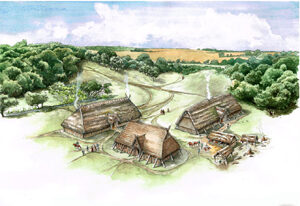Lyminge is rich with archaeology and many excavations over the years have shown a variety of archaeological finds. Archaeological evidence has been discovered from the Mesolithic, some 8-10,000 years ago just after the end of the last Ice Age, for hunters making a camp by the source of the Nailbourne on Well Field, and there have been finds of two flint axe heads made by the first farmers of the Neolithic, some 4-5,000 years ago. There were Bronze Age graves on Tayne Field in the middle of Lyminge, and also on the site of the new housing development by the New Lyminge Surgery. Strangely. though stray finds have been discovered, there is no evidence for occupation during the Iron Age from around 500BC, nor during the period of Roman rule in the first four centuries AD. But people were living in Lyminge again and burying their dead here from the end of the 5th Century, and there has been continuous occupation ever since, giving Lyminge an unusually long existence right through the medieval period.
An early interest in the archaeology of Lyminge was shown by the Rector from 1854-96, Canon Robert Jenkins who was one of the founder members of the Kent Archaeological Society. He discovered the remains of a 7th Century church, built in the first phase of the conversion following the arrival of St Augustine in Kent, who was sent by the Pope in Rome in 597 AD. When the Elham Valley Railway was built in the 1880s, artefacts from a 5th-6th Century cemetery were found. In the 1950s, another cemetery of this period was discovered when a mushroom shed was being constructed in a field off Canterbury Road. Excavations at that time and subsequently in advance of building work have led to the discovery of some very interesting grave artefacts, many of which are now on display in Maidstone Museum.
Between 2008 and 2015 Dr Gabor Thomas, assisted by Dr Alexandra Knox and a team from the University of Reading undertook a programme of archaeological excavation in Lyminge. This revealed a complex of timber halls on Tayne Field dating from the mid 6th to the mid 7th Centuries, almost certainly the centre of the royal estate that is recorded in historical documents. Around the church was found evidence for the monastic community that is known to have existed, and this appears to have been there from at least the end of the 7th Century into the later 9th Century. The final report on these excavations is still being prepared, but summary findings for each season’s work can be accessed by following the links below.
Pathways to the Past was a community based project that in 2019 enabled re-excavation of the 7th Century church originally excavated by Canon Jenkins in 1859. Gabor Thomas returned to Lyminge to lead this excavation, which enabled us to gain a much better understanding of what Canon Jenkins had found. The report on the 2019 excavation is now available on-line.
More recently, the new housing development by New Lyminge Surgery enabled extensive archaeological exploration during the Covid lock-down prior to building work commencing. As well as the Bronze Age burials already mentioned above, evidence was found for a number of sunken-featured buildings, normally identified as storage buildings or workshops for activities like weaving during the early medieval period of the 5th to 7th Centuries. These would have stood close to the cemetery of the same period that lies under Greenbanks, and are part of an extensive area of settlement that includes similar structures at the end of Rectory Lane, as well as the hall complex on Tayne Field.
You can learn more about the history of Lyminge on the Lyminge Parish Council website.

The excavation led by Dr Gabor Thomas and his team at the University of Reading in 2008-15 was funded by the Arts and Humanities Research Council.
The project was based at the University of Reading, but also involved professional archaeologists from Canterbury Archaeological Trust, student trainees, volunteers from local archaeological groups and local residents from Lyminge and neighbouring communities. The project was recognised nationally by being highly commended in the 2012 British Archaeology Awards’ category of “Best Project”. Gabor was runner up in the British Archaeology Awards for 2022 in the category “Archaeologist of the Year” in recognition for all his work in Lyminge.
